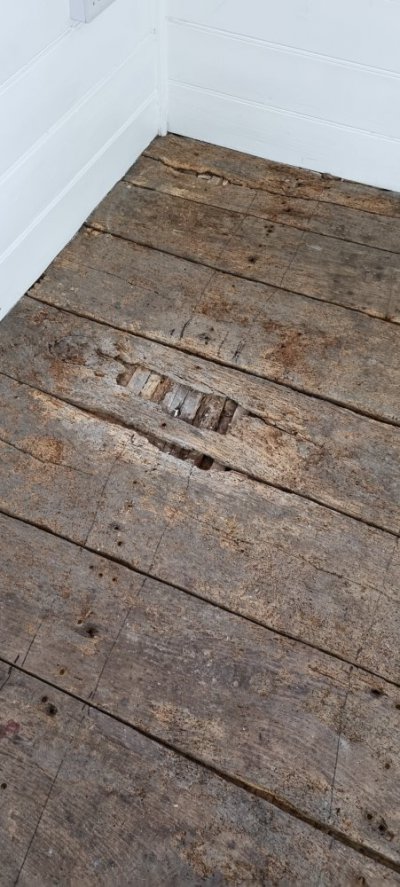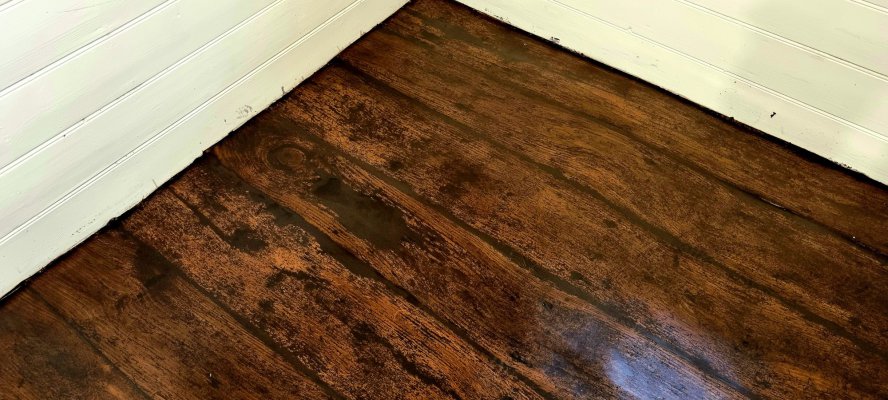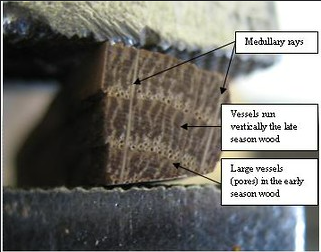Greetings. Thanks for taking the time to read this.
Have recently joined the forum… have been reading some of the historical posts for insight. Purchased an 1870 ish cottage at the start of 2020. Knew historically that it had had big issues with condensation, could drip down walls etc, PIV system was put in. There are localised damp patches near the base of some of the downstairs walls, worse on internal walls and were tide marks on the chimney breast and walls close by. My surveyor was not unduly concerned and an experienced period plasterer told me to let sleeping dogs lie. Ground levels at the front are somewhat too high so need addressing. The property had been empty for 15 months prior to completion and I was not able to be there much for the first couple of years so heating was left low with not a great deal of ventilation. Not great I know. My big concern is that I believe woodworm has taken hold in areas, not just common furniture beetle but possibly death watch…think I have seen a few of the latter wrapped in spiders webs. I saw some rather decaying wood in the corner of the property when I looked round but didn’t think twice about it. I have had a few firms round to assess, lift floorboards, look in the loft and there appears to be disagreement. There was a couple of patches of frass found on the loft timbers which was highlighted and some floorboards were lifted as I had felt sagging… certainly edges have been lost in places, there are some fresh holes and there seemed to be some frass. The recommendation was spraying and damp course injections and cement etc which on reading your helpful posts and listening to Peter Ward I know not to do. I a grateful for reading the previous posts that elimination of moisture in the timbers / relative humidity is key. The main external beams in the downstairs rooms are painted so will retain more moisture. The meter was reading 12.6 a few weeks ago and 9.6 a few days ago. I know this is not a very deep reading in the wood though….am thinking about beetle’s preferred environment. A few questions if I may for any resident specialists… Matt and others…?
Many thanks.
Turiya
Have recently joined the forum… have been reading some of the historical posts for insight. Purchased an 1870 ish cottage at the start of 2020. Knew historically that it had had big issues with condensation, could drip down walls etc, PIV system was put in. There are localised damp patches near the base of some of the downstairs walls, worse on internal walls and were tide marks on the chimney breast and walls close by. My surveyor was not unduly concerned and an experienced period plasterer told me to let sleeping dogs lie. Ground levels at the front are somewhat too high so need addressing. The property had been empty for 15 months prior to completion and I was not able to be there much for the first couple of years so heating was left low with not a great deal of ventilation. Not great I know. My big concern is that I believe woodworm has taken hold in areas, not just common furniture beetle but possibly death watch…think I have seen a few of the latter wrapped in spiders webs. I saw some rather decaying wood in the corner of the property when I looked round but didn’t think twice about it. I have had a few firms round to assess, lift floorboards, look in the loft and there appears to be disagreement. There was a couple of patches of frass found on the loft timbers which was highlighted and some floorboards were lifted as I had felt sagging… certainly edges have been lost in places, there are some fresh holes and there seemed to be some frass. The recommendation was spraying and damp course injections and cement etc which on reading your helpful posts and listening to Peter Ward I know not to do. I a grateful for reading the previous posts that elimination of moisture in the timbers / relative humidity is key. The main external beams in the downstairs rooms are painted so will retain more moisture. The meter was reading 12.6 a few weeks ago and 9.6 a few days ago. I know this is not a very deep reading in the wood though….am thinking about beetle’s preferred environment. A few questions if I may for any resident specialists… Matt and others…?
- If an infestation took hold when the moisture in the timbers was much higher for a few years but then this is reduced, what happens to the eggs and larvae? How low does the reading have to go and for what period of time for both death watch and common furniture beetle larvae to die or do there just go dormant and can be ‘reanimated’ many years later if the moisture level increases again?
- In respect to the floorboards upstairs, if I have a number of them lifted for a couple of months to increase ventilation to the joists etc and keep tabs on the moisture readings, could this work in killing off the infestation?
- I have seen a couple of what may be dead long horns (not the classic house one but large, different colour and similar body construction). Does the same logic apply for them in situ in respect to reduction of timber moisture below a certain point…?
- I know the fallacy of so called moisture readings on walls but if, where the main oak beams enter the walls, shows green on the machine, are the ends in danger ? (one does meet an external wall).
- Would I need to increase ventilation in the loft to combat the small outbreak there? Currently have soffit vents for that and insulation down.
- Been looking for pheromone traps for both types of beetle to little avail. Any ideas and would this be useful…? Am a bit reluctant with general glue traps as may get the spiders, indeed any other life, as well.
- Excuse the ignorance, but how do you ventilate the subfloor void at an upper level if no external ventilation bricks ?
Many thanks.
Turiya




